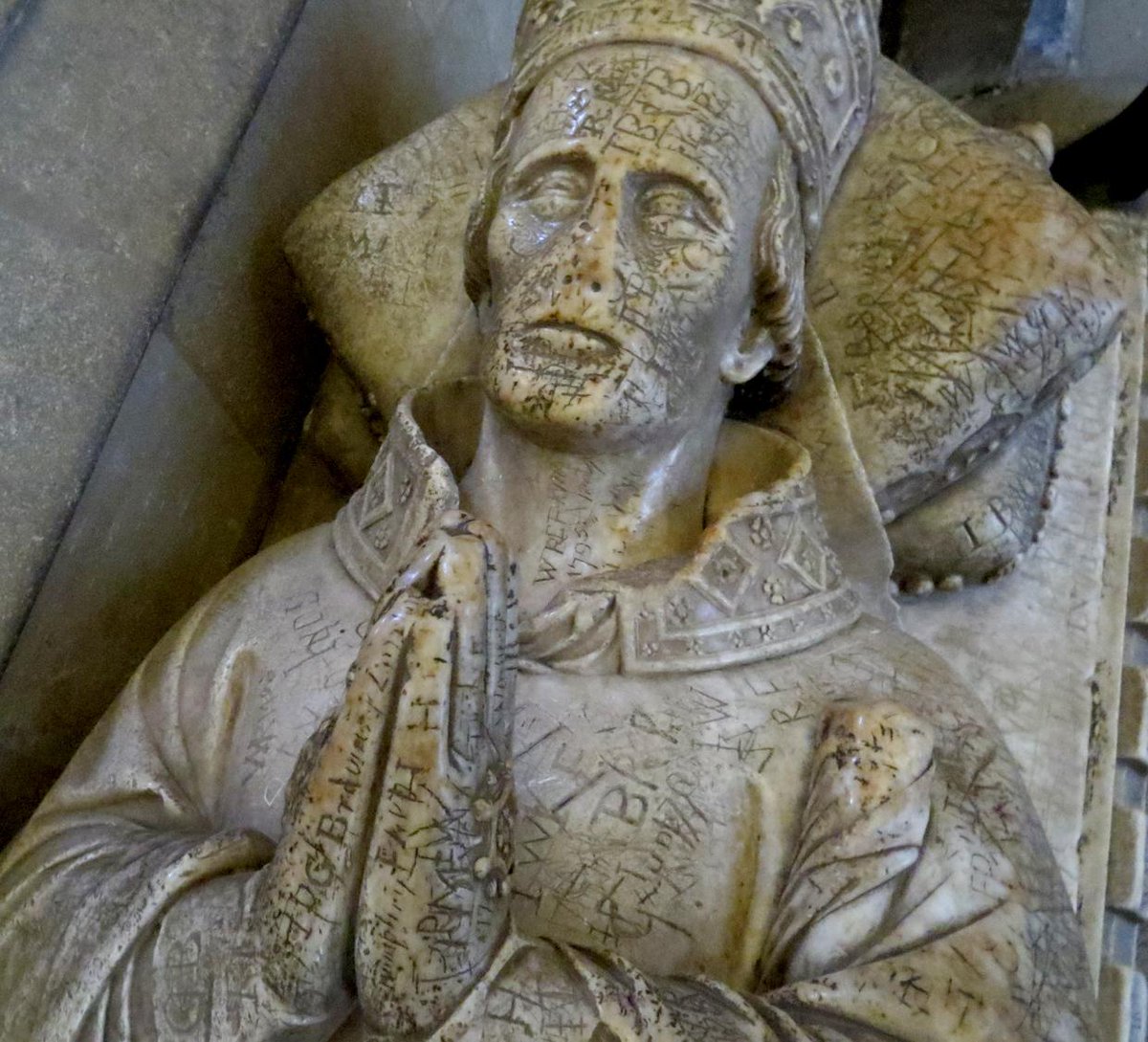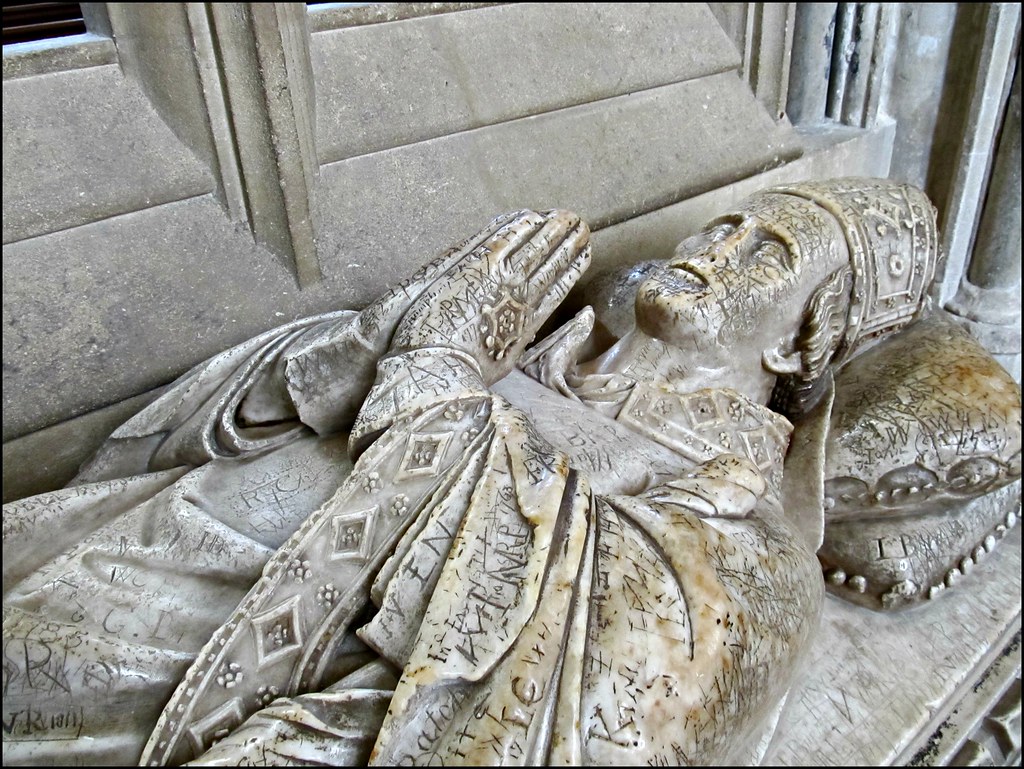One of the earliest surviving alabaster effigies dedicated to a member of the higher clergy is the effigy of Ralph of Shrewsbury, Bishop of Bath and Wells, who died in 1363. This remarkable piece of medieval craftsmanship can be found in the stunning Wells Cathedral in Somerset, England. In this blog post, we’ll explore the rich history, significance, and unique features of Bishop Ralph’s effigy, as well as his lasting contributions to the church and local community.
The History of Bishop Ralph’s Effigy

Bishop Ralph’s effigy originally held a place of great honor, positioned prominently in the middle of the choir before the high altar in Wells Cathedral. However, around 1550, it was moved from the choir and placed in its current location in the North Choir Aisle. Evidence from graffiti patterns and dates suggests that the effigy has been in this position since at least the early eighteenth century. The left side of the effigy is heavily marked with graffiti, while the right side, which is against the wall, remains almost untouched. Despite this, the effigy is remarkably well-preserved, offering a glimpse into the skilled craftsmanship of the medieval period.
Detailed Description of the Effigy

The effigy depicts Bishop Ralph lying recumbent, with his head supported by a pair of pillows and his hands in prayer. The craftsmanship of the carving is exquisite, with the head of his staff, though now broken off, originally fully undercut. A particularly notable feature of the effigy is his mitre, shown hinged at both sides and secured by pins. This unique detail served as a model for the effigy of Bishop Harewell, who died in 1386. Bishop Harewell’s effigy, also made of alabaster, features a hinged mitre and replaces the two collared dogs at Bishop Ralph’s feet with two hares, a pun on Harewell’s name.
Bishop Ralph’s Life and Legacy

Ralph of Shrewsbury, despite his obscure origins, was a prominent figure in the church. He served as Chancellor of Oxford University from 1328 to 1329 and was unanimously elected Bishop of Bath and Wells by the monks of Bath and the canons of Wells in 1329. His consecration took place without the Pope’s assent, resulting in Bishop Ralph having to pay 2,000 florins to the Roman treasury. However, his legacy is largely defined by his pastoral activities and his reputation for sanctity.
As Bishop of Bath and Wells, Ralph of Shrewsbury restored many of the palaces associated with the see and fortified the episcopal palace at Wells with lofty walls and a deep moat. It is also likely that he played a significant role in recasting the eastern limb of Wells Cathedral, further enhancing the architectural splendor of the cathedral.
Contributions to the Clergy and Community
Bishop Ralph’s principal benefactions at Wells were aimed at supporting the minor clergy. He founded the college of vicars, secured a license of incorporation for them, and provided them with dwellings, a chapel, and a hall in ‘the vicars close,’ allowing them to live together. He also ensured they had an endowment separate from the capitular estates and established rules for their conduct. The vicars close still stands today, a testament to Bishop Ralph’s commitment to the well-being and support of the lesser clergy.
A commemorative panel painting in Wells Cathedral, dating from the late-sixteenth or early-seventeenth century, depicts the vicars kneeling at the bishop’s feet with an inscription expressing their gratitude for the provided lodgings. This painting serves as a poignant reminder of Bishop Ralph’s legacy and the lasting impact of his pastoral care and support for the clergy.
Conclusion
The alabaster effigy of Bishop Ralph of Shrewsbury is not only a remarkable example of medieval craftsmanship but also a testament to the bishop’s significant contributions to Wells Cathedral and the broader church community. His legacy, marked by his pastoral care and support for the minor clergy, continues to be remembered and honored through his effigy and the enduring structures he helped establish.
The intricate details and unique features of Bishop Ralph’s effigy, such as the hinged mitre and the pun-filled effigy of Bishop Harewell, offer a fascinating glimpse into the artistic and cultural traditions of the medieval period. As we explore this remarkable piece of history, we are reminded of the enduring impact that dedicated church leaders can have on their communities and the lasting legacy they leave behind.
